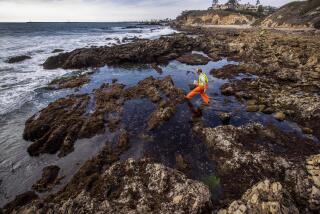Time Oozes On at Valdez
- Share via
Investigations into the tanker Exxon Valdez disaster in Alaska’s Prince William Sound on March 24 will continue for months, but the angry comment of one fishing boat captain on April 12 helps to explain a major part of the problem: “We are out here working our hearts out without accomplishing anything because there’s no one in charge and that’s the real problem.”
That was nearly three weeks after the grounding of the Exxon Valdez on Bligh Reef. On the next day, Admiral Paul A. Yost, the commandant of the U.S. Coast Guard, arrived in Valdez to take charge of the federal government’s role in the cleanup of the 240,000-barrel oil spill. At last, someone could be seen actually giving some orders. Still, Yost was only in charge of the federal government’s role in the cleanup, not in charge--period. President Bush had declined, and continues to decline, to take full control of the situation.
Up until Yost’s arrival, Exxon still had not issued any comprehensive cleanup plan. In fact, the giant oil firm did not do so until last weekend, after Yost had demanded one. Even then, both Yost and Alaskan state officials questioned the sufficiency of the plan to clean crude oil from beaches only in Prince William Sound. By this week, the slick had spread well beyond the sound, as far as 250 miles from Valdez, and had lapped onto the shores of two national parks.
“There’s no one in charge.” That seems to have been a critical problem from the moment that the Exxon Valdez ran onto the reef a little less than three hours after leaving Valdez, the terminal of the Trans-Alaska Pipeline System, with 1.26 million barrels of oil aboard, bound for Long Beach. At the outset, Alyeska Pipeline Service Co., the consortium of seven oil companies that operates the pipeline and oil terminal, was responsible for responding to an oil-spill emergency. The consortium’s prepared contingency plan had offered assurance that any spill in the sound would be contained within five hours. It was clear that a speedy response was critical. But Alyeska’s standby emergency oil team was abolished in the early 1980s to save money.
The Coast Guard log of the oil spill tells the rest of the story. More than seven hours after the accident, at 7:27 a.m. on March 24, an Alyeska helicopter reported observing a slick 1,000 feet wide and 4-to-5 miles long. At 9:50 a.m., the Coast Guard noted that Alyeska boats were under way with estimated arrival at the Exxon Valdez at 1 p.m. The first Alyeska equipment actually arrived at 2:30 p.m., and the ship was not finally surrounded by a containment boom until 11 a.m. on Saturday, March 25, or 35 hours after the accident.
Had any such spill occurred in San Pedro Bay as the Exxon Valdez navigated into the Port of Long Beach, the Coast Guard would have been immediately and fully in charge. This is what should have occurred in Valdez on March 24. Nearly one month afterward, this is still what should occur.
More to Read
Sign up for Essential California
The most important California stories and recommendations in your inbox every morning.
You may occasionally receive promotional content from the Los Angeles Times.













